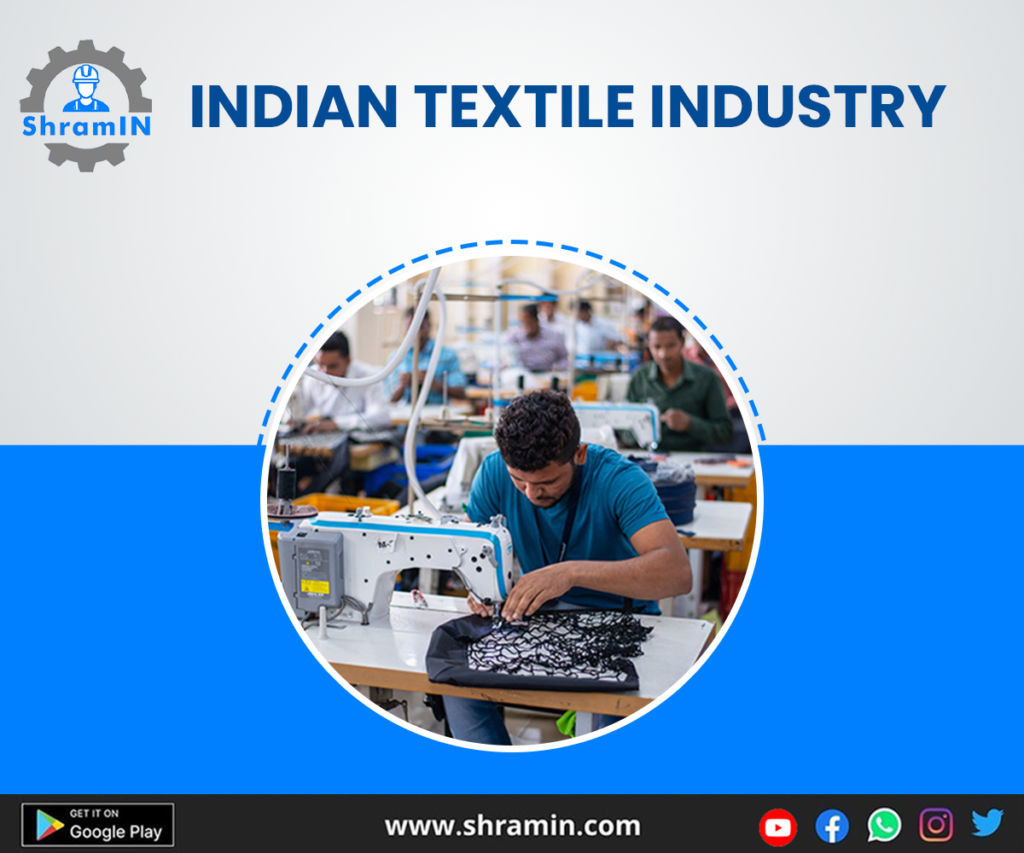An industry that is primarily concerned with the production, design and distribution of yarn, cloth and textile is known as the textile industry. In India, the textile industry is one of the oldest industries. Its history almost traces back to the Indus Valley Civilization, where homespun cotton fabrics were used to get made. Although this traditional textile industry got ruined during colonialism. In the early 19th century, the modern textile industry took place. At present, it is a self-reliant industry. From the production of raw material to man-made fibre to apparel to delivery of the finished product, the Indian textile industry has strength across the entire value chain.

Structure of Indian Textile Industry:
India handles the entire manufacturing process including spinning, weaving, dyeing, printing, finishing and garment manufacturing. And it deals with various kinds of textiles fibres like: Natural Fibers: It involves plant-based fibres like cotton, jute, linen etc. And another is animal-based fibres, like wool and silk.
Man-made Fibers: It involves cellulosic fibres, like viscose fibre, modal, etc. And synthetic fibres, like polyester, acrylic and polypropylene.
But cotton dominates the Indian textile industry by 60%. Therefore, India is the largest producer of cotton in the world.
Sectors and Sub-sectors:
Organised: Spinning mills, composite mills and large weaving mills come under this category, which deals with spinning, apparel and garments. The facility and resources these mills consist of are well efficient and hi-tech. It is a capital intensive sector, which takes a major chunk of government investment in the textile industry in India.
Unorganised: It majorly deals with industries that are small in scale-like handlooms, power looms, hosiery or knitting yarn and fabric processing units. And this sector dominates the Indian textile industry, as 75% of fabric comes from the unorganised sector. These are cottage industries or small scale industries that use traditional methods and tools.
Types of jobs the textile industry provides:** Screen printer Dyeing supervisor Spinner Weaver Stylist Cloth inspector Textile tester Colourist Spreader cutter Alteration Hand Knitting machine technician Laboratory technician Loom technician Machine operator Machine technician Sewing Machine Operator Pattern Maker & grader
Current Status of the textile industry:
Now India is one of the largest producers of the apparel and textile Industry. It alone contributes around 14% to overall industrial production in India. India ranks at 6th largest in the world as a textile and apparel exporter. Therefore, the textile sector contributes 12% of India’s export earnings and 5% to the country’s GDP. The size of the Indian textile industry can be estimated by the fact that employment to more than 45 million people, second largest employer after agriculture.
Indian Textile Industry Fall in Covid-19 The Indian textile industry’s worth is marked at US$106 billion in 2019-2020. But the market fell by 30% during covid-19. Therefore in 2020-21, it was estimated at US$75 billion. There is an expectation that the market will recover and grow at 10% to 11% CAGR to reach US$190 billion by 2025-26.
Steps to boost the industry:
Mega Textile Parks: The central government has taken an initiative to build a 7 PM Mega Integrated Textile and Apparel (MITRA) Park in the country to upgrade the Indian textile industry globally. The aim is to reach US$190 by 2025-26. Technical Textile: Lately, technical textile has gained momentum in recent years. And to maintain the growth, the central government is taking steps to boost the sector. There is an estimation of 300% growth in the next two years. The Textile Ministry has reviewed the Amended Technology Up-gradation Fund Scheme (ATUFS) to upgrade the textile industry by increasing the ease of doing business, developing new job opportunities. RoSCTL Scheme: The government has extended the Rebate of State and Central Taxes and Levies (RoSCTL) scheme for textile exporters till March 2024. Under this garment exporters can continue to get rebates over the state and central taxes they pay on outward shipments.
ShramIN
It is an initiative for the employers of small scale industries or MSME to hire factory and manufacturing workers, ITI candidates, skilled and semi-skilled workers. It also caters the job seekers who are searching for blue-collar jobs. So, shramin.com is a medium between the employer and the job seeker that bridges the supply gap of blue-collar workers.
Most of the above-mentioned jobs are available at ShramIN job portals if you are looking for jobs in the textile industry. And the same job profile candidates are available on ShramIN Recruit for employers working in the same industry. Whether you are an employer or job seeker, shramin.com is helping both departments without charging any fees. It is free of cost job portal. So, if you have not registered yourself yet, what are you waiting for? Thousands of candidates have already registered. You can do it too.
Visit our website www.shramin.com or download our app ShramIN Recruit (for employers) or ShramIN Jobs App (for jobseekers).
